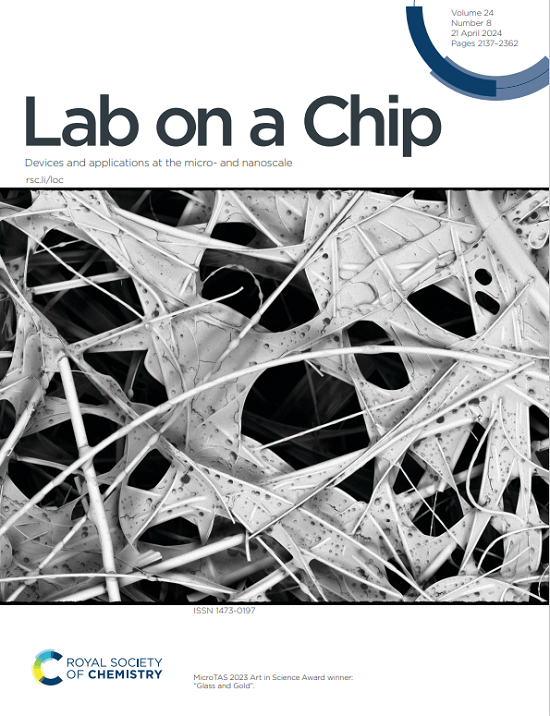Evaluating Caplacizumab’s Potential to Mitigate Thrombosis Risk in Aortic Valve Stenosis: A Microfluidic and Computational Approach
IF 5.4
2区 工程技术
Q1 BIOCHEMICAL RESEARCH METHODS
引用次数: 0
Abstract
Aortic valve stenosis is a progressive cardiovascular disease associated with increased thrombotic risk due to abnormal blood flow patterns. Current management often culminates in valve replacement surgery, demonstrating the need for less invasive therapeutic options. This study investigates the potential of caplacizumab, a von Willebrand factor (vWF) inhibitor, in mitigating thrombosis risk in a microfluidic model of aortic valve stenosis. We employed a novel microfluidic model simulating the hemodynamics of healthy, moderate, and severe stenotic conditions, complemented by computational fluid dynamics simulations (CFD) and conventional platelet function assays. Microfluidic experiments revealed that shear gradients play a critical role in platelet aggregation, with accumulation intensifying as stenosis severity increased, even under constant peak shear rates. Caplacizumab demonstrated high specificity for vWF-mediated platelet activation, significantly inhibiting ristocetin-induced aggregation while not affecting ADP-induced aggregation. At an effective concentration (30 nM), caplacizumab reduced platelet coverage by up to 90% in high shear conditions (4500 s-1) and effectively mitigated shear gradient-dependent platelet aggregation across all stenotic conditions. These findings highlight caplacizumab's therapeutic potential for thrombosis prevention in patients with aortic valve stenosis, offering a foundation for personalized antithrombotic approaches that could potentially reduce thrombotic complications associated with the disease.评估Caplacizumab降低主动脉瓣狭窄血栓形成风险的潜力:微流体和计算方法
主动脉瓣狭窄是一种进行性心血管疾病,与异常血流模式引起的血栓形成风险增加有关。目前的治疗往往以瓣膜置换术告终,这表明需要微创治疗方案。本研究探讨了血管性血液病因子(vWF)抑制剂caplacizumab在主动脉瓣狭窄微流控模型中降低血栓形成风险的潜力。我们采用了一种新的微流体模型来模拟健康、中度和重度狭窄条件下的血流动力学,并辅以计算流体动力学模拟(CFD)和传统的血小板功能分析。微流体实验表明,剪切梯度在血小板聚集中起着关键作用,即使在恒定的峰值剪切速率下,随着狭窄程度的增加,血小板聚集也会加剧。Caplacizumab对vwf介导的血小板活化具有高特异性,可显著抑制利斯托司汀诱导的聚集,而不影响adp诱导的聚集。在有效浓度(30 nM)下,caplacizumab在高剪切条件下(4500 s-1)可将血小板覆盖率降低高达90%,并有效减轻所有狭窄条件下剪切梯度依赖性血小板聚集。这些发现强调了caplacizumab在预防主动脉瓣狭窄患者血栓形成方面的治疗潜力,为个性化抗血栓治疗方法提供了基础,可能减少与该疾病相关的血栓并发症。
本文章由计算机程序翻译,如有差异,请以英文原文为准。
求助全文
约1分钟内获得全文
求助全文
来源期刊

Lab on a Chip
工程技术-化学综合
CiteScore
11.10
自引率
8.20%
发文量
434
审稿时长
2.6 months
期刊介绍:
Lab on a Chip is the premiere journal that publishes cutting-edge research in the field of miniaturization. By their very nature, microfluidic/nanofluidic/miniaturized systems are at the intersection of disciplines, spanning fundamental research to high-end application, which is reflected by the broad readership of the journal. Lab on a Chip publishes two types of papers on original research: full-length research papers and communications. Papers should demonstrate innovations, which can come from technical advancements or applications addressing pressing needs in globally important areas. The journal also publishes Comments, Reviews, and Perspectives.
 求助内容:
求助内容: 应助结果提醒方式:
应助结果提醒方式:


